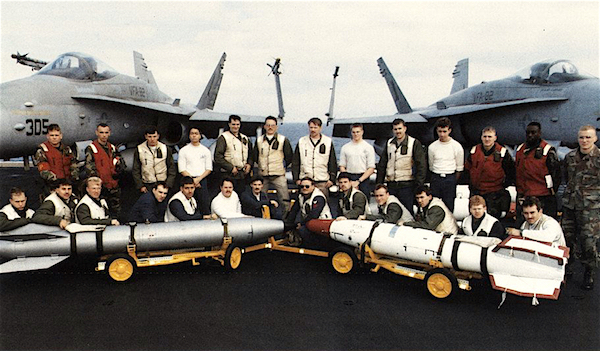
Declassified: US Nuclear Weapons At Sea
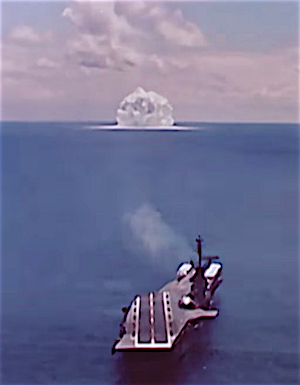
ASROC nuclear test, 1962
Remember during the Cold War when US Navy warships and attack submarines sailed the World’s oceans bristling with nuclear weapons and routinely violated non-nuclear countries’ bans against nuclear weapons on their territories in peacetime?
The weapons were onboard ballistic missile submarines, attack submarines, aircraft carriers, battleships, cruisers, destroyers, frigates and supply ships. The weapons were brought along on naval exercises, spy missions, freedom of navigation demonstrations and port visits.
Sometimes the vessels they were on collided, ran aground, caught fire, or sank.
Not many remember today. But now the Pentagon has declassified how many nuclear weapons they actually deployed in the Atlantic, Pacific, and Mediterranean. In our latest FAS Nuclear Notebook published in the Bulletin of the Atomic Scientists we review this unique new set of de-classified Cold War nuclear history.
The Numbers
The declassified documents show that the United States during much of the 1970s and the 1980s deployed about a quarter of its entire nuclear weapons stockpile at sea. The all-time high was in 1975 when 6,191 weapons were afloat, but even in 1990, after the fall of the Berlin Wall, there were 5,716 weapons at sea. That’s more nuclear weapons than the size of the entire US nuclear stockpile today.
The declassified data provides detailed breakdowns for weapons in the Atlantic, Pacific, and Mediterranean for the 30-year period between 1961 and 1991. Prior to 1961 only totals are provided. Except for three years (1962, 1965 and 1966), most weapons were always deployed in the Atlantic, a reflection of the focus on defending NATO against the Soviet Union. When adding the weapons in the Mediterranean, the Euro-centric nature of the US nuclear posture during the Cold War becomes even more striking. The number of weapons deployed in the Pacific peaked much later, in 1987, at 2,085 weapons.
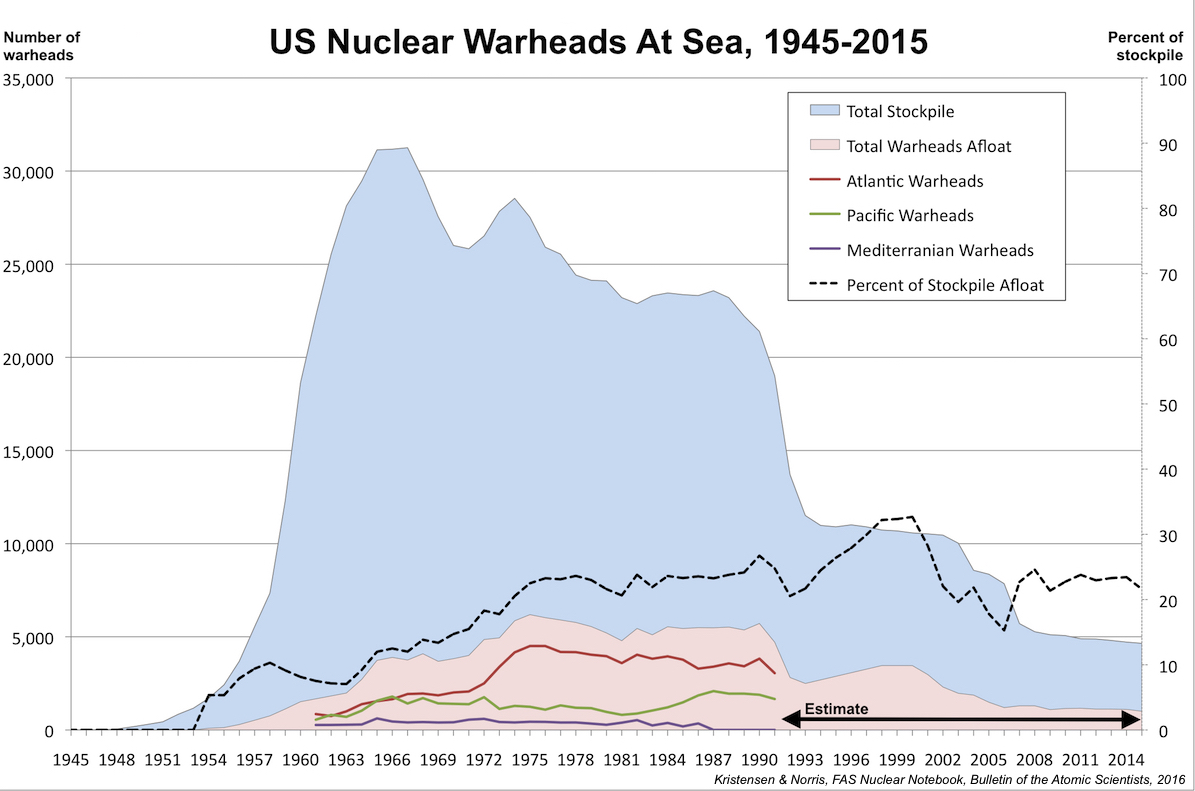
The declassified numbers end in 1991 with the offloading of non-strategic naval nuclear weapons from US Navy vessels. After that only strategic missile submarines (SSBNs) have continued to deploy with nuclear weapons onboard. Those numbers are still secret.
In the table above we have incorporated our estimates for the number of nuclear warhead deployed on US ballistic missile submarines since 1991. Those estimates show that afloat weapons increased during the 1990s as more Ohio-class SSBNs entered the fleet.
Because the total stockpile decreased significantly in the early 1990s, the percentage of it that was deployed at sea grew until it reached an all-time high of nearly 33 percent in 2000. Retirement of four SSBNs, changes to strategic war plans, and the effect of arms control agreements have since reduced the number of nuclear weapons deployed at sea to just over 1,000 in 2015. That corresponds to nearly 22 percent of the stockpile deployed at sea.
The just over 1,000 afloat warheads today may be less than during the Cold War, but it is roughly equivalent to the nuclear weapons stockpiles of Britain, China, France, India, Israel, Pakistan and North Korea combined.
Mediterranean Mystery
The declassification documents do not explain how the numbers are broken down. The “Atlantic,” “Pacific,” and “Mediterranean” regions are not the only areas where the U.S. Navy sent nuclear-armed warships. Afloat weapons in the Indian and Arctic oceans, for example, are not listed even though nuclear-armed warships sailed in both oceans. Similarly, the declassified documents show the number of afloat weapons in the Mediterranean suddenly dropping to zero in 1987, even though the U.S. Navy continued so deploy nuclear-armed vessels into the Mediterranean Sea.
During the naval deployments in support of Operation Desert Storm against Iraq in early 1991, for example, the aircraft carrier USS America (CV-66) deployed with its nuclear weapons division (W Division) and B61 nuclear strike bombs and B57 nuclear depth bombs. The W Division was still onboard when America deployed to Northern Europe and the Mediterranean in 1992 but had been disbanded by the time it deployed to the Mediterranean in 1993.

B61 and B57 nuclear weapons are displayed on board the USS America (CV-66) during its deployment to Operation Desert Storm in 1991. The nuclear division was also onboard in 1992 but gone in 1993.
As ships offloaded their weapons, the on-board nuclear divisions gradually were disbanded in anticipation of the upcoming denuclearization of the surface fleet. One of the last carriers to deploy with a W Division was the USS John F. Kennedy (CV-67), which upon its return to the United States from a Mediterranean deployment in 1992-1993 ceremoniously photographed the W crew with the sign: “USS John F. Kennedy, CV 67, last W-Division, 17 Feb. 93.” The following year, the Clinton administration publicly announced that all carriers and surface ships would be denuclearized.
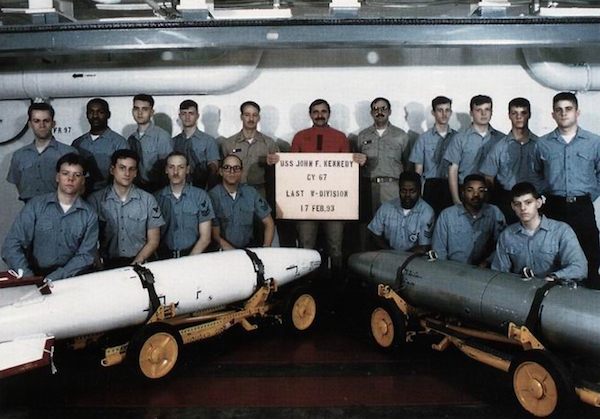
The last nuclear weapons division on the USS John F. Kennedy (CV-67) is disbanded in February 1993. The following year the entire surface fleet was denuclearized.
Since nuclear weapons clearly deployed to the Mediterranean Sea after the declassified documents showing zero afloat nuclear weapons in the area, perhaps the three categories “Atlantic,” “Pacific,” and “Mediterranean” refer to overall military organization: “Atlantic” might be weapons under the command of the Atlantic Fleet (LANTFLT); “Pacific” might refer to the Pacific Fleet (PACFLT); and “Mediterranean” might refer to the Sixth Fleet. Yet I’m not convinced that organization is the whole story; the Atlantic numbers didn’t suddenly increase when the Mediterranean numbers dropped to zero.
The declassified afloat numbers end in 1991. After that year the only nuclear weapons deployed at sea have been strategic weapons onboard ballistic missile submarines. Most of those deploy in the Atlantic and Pacific but have occasionally deployed into the Mediterranean even after the declassified documents list zero afloat weapons in that region, and even after the surface fleet was denuclearized.
In 1999, for example, the ballistic missile submarine USS Louisiana (SSBN-743) conducted a port visit to Souda Bay on Crete with it load of 24 Trident missiles and an estimated 192 warheads. The ship’s Command History states that the port visit, which took place December 12-16, 1999, occurred during the “Alert Strategic Deterrent Patrol in support of national tasking” that included a “Mediterranean Sea Patrol.”
Risks of Nuclear Accidents
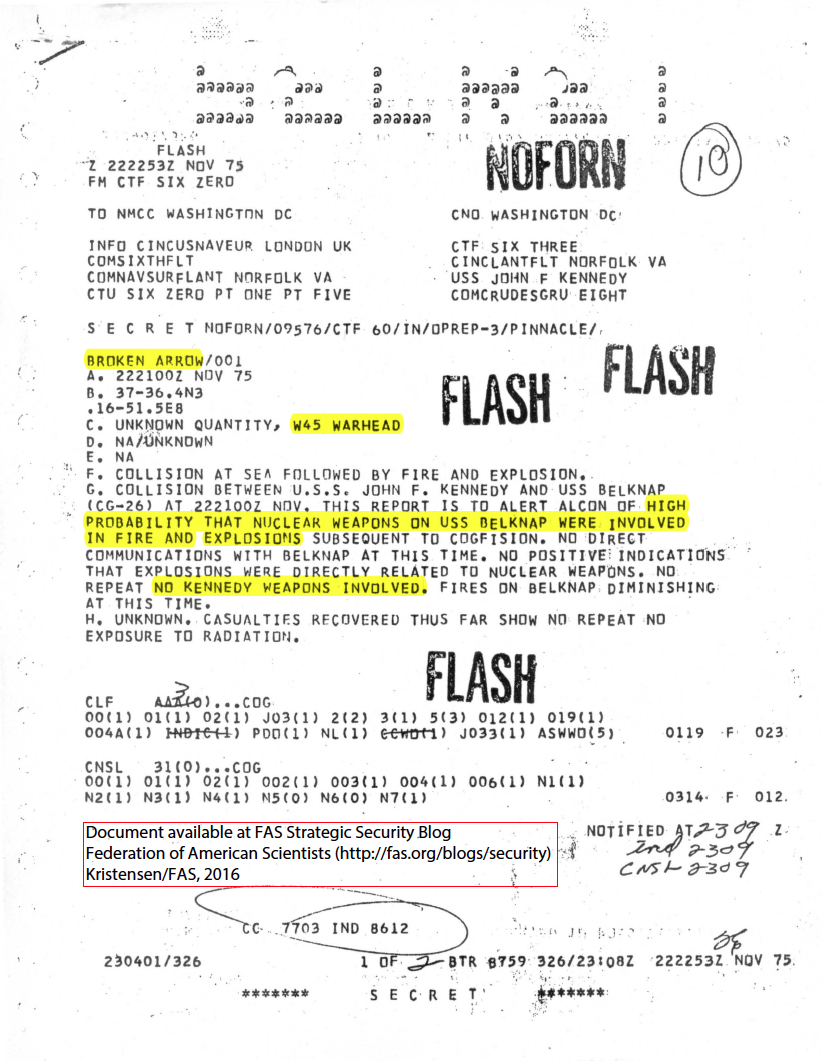
Deploying nuclear weapons on ships and submarines created unique risks of accidents and incidents. Because warships sometimes collide, catch fire, or even sink, it was only a matter of time before the nuclear weapons they carried were threatened, damaged, or lost. This really happened.
During night air exercises on November 22, 1975, for example, the aircraft carrier USS John F. Kennedy (CV-67) and cruiser USS Belknap (CG-26) collided in rough seas 112 kilometers (70 miles) east of Sicily. The carrier’s flight deck cuts into the superstructure of the Belknap setting off fires on the cruiser, which burned out of control for two-and-one-half hours. The commander of Carrier Striking Force for the U.S. Sixth Fleet on board the Kennedy issues a Broken Arrow alert to higher commands stating there was a “high probability that nuclear weapons (W45 Terrier missile warheads) on the Belknap were involved in fire and explosions.” Eventually the fire was stopped only a few meters from Belknap’s nuclear weapons magazine.
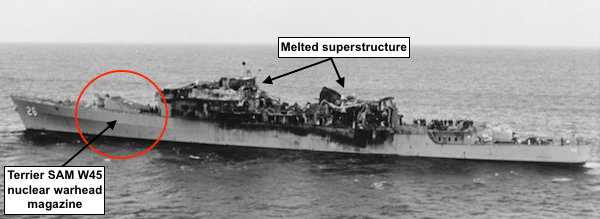
The fire-damaged USS Belknap (CG-26) after colliding with USS John F. Kennedy (CV-67) new Sicily in 1975. The fire stopped a few meters from the nuclear warhead magazine.
The Kennedy also carried nuclear weapons, approximately 100 gravity bombs for delivery by aircraft. The carrier caught fire but luckily it was relatively quickly contained. Another carrier, the USS Enterprise (CVN-65), had been less fortunate six years earlier when operating 112 kilometers (70 miles) southwest of Pearl Harbor, Hawaii. A rocket on a F-4 Phantom aircraft exploded puncturing fuel tanks and starting violent fires that caused other rockets and bombs to explode. The explosions were so violent that they tore holes in the carrier’s solid steel deck and engulfed the entire back of the ship. The captain later said: “If the fire had spread to the hangar deck [below], we could have very easily lost the ship.” The Enterprise probably carried about 100 nuclear bombs and was powered by eight nuclear reactors.
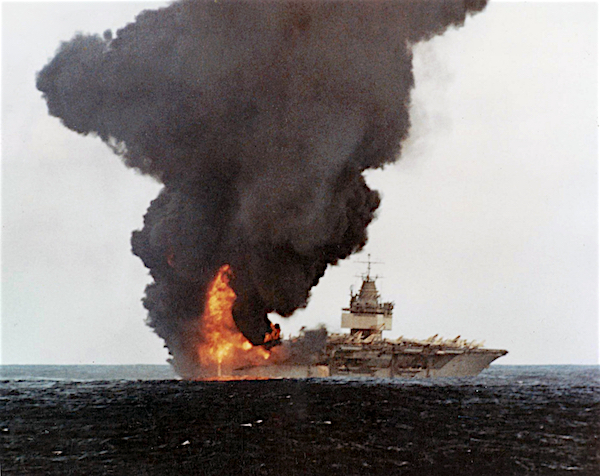
The nuclear-armed and nuclear-powered USS Enterprise (CVN-65) burns off Hawaii on January 14, 1969. The carrier could have been lost, the captain said.
Dozens of nuclear weapons were lost at sea over the decades because they were on ships, submarines, or aircraft that were lost. On December 5, 1965, for example, while underway from operations off Vietnam to Yokosuka in Japan, an A-4E aircraft loaded with one B43 nuclear weapon rolled overboard from the Number 2 Elevator. The aircraft sank with the pilot and the bomb in 2,700 fathoms (4,940 meters) of water. The bomb has never been recovered. The Department of Defense reported the accident took place “more than 500 miles [805 kilometers] from land” when it revealed the accident in 1981. But Navy documents showed the accident occurred about 80 miles (129 kilometers) east of the Japanese Ryukyu Island chain, approximately 250 miles (402 kilometers) south of Kyushu Island, Japan, and about 200 miles (322 kilometers) east of Okinawa. Japan’s public policy and law prohibit nuclear weapons. (For a video if B43 aircraft carrier handling and A-4 loading, see this video.)
An A-4 Skyhawk with a B43 nuclear bomb under its belly rises on an elevator from the hangar deck to the flight deck on the USS Independence (CV-62) in an undated US Navy photo. In December 1965, a B43 attached to an A-4 rolled off the elevator on the USS Ticonderoga (CVA-14) while the carrier was on its way to Yokosuka in Japan.
Three years later, on May 27, 1968, the nuclear-powered attack submarine USS Scorpion (SSN-589) suffered an accident and sank with all 99 men on board in the Atlantic Ocean approximately 644 kilometers (400 miles) southwest of the Azores. The Department of Defense in 1981 mentioned a nuclear weapons accident occurred in the Atlantic in the spring of 1968 but continues to classify the details. It is thought that two nuclear ASTOR torpedoes were on board the Scorpion when it sank.
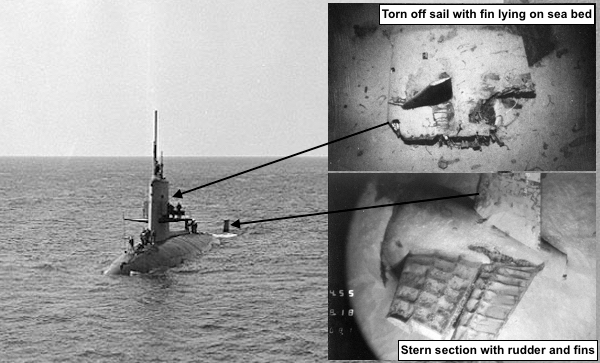
The USS Scorpion (SSN-589) photographed in the Mediterranean Sea in April 1968, one month before it sank in the Atlantic Ocean. The Navy later located and photographed the wreck (inserts).
Risks of Nuclear Incidents
Another kind of risk was that nuclear weapons onboard US warships could become involved in offensive maneuvers near Soviet warships that also carried nuclear weapons. Sometimes those nuclear-armed vessels collided – sometimes deliberately. Other times they were trapped in stressful situation. The presence of nuclear weapons could significantly increase the stakes and symbolism of the incidents and escalate a crisis.
Some of the most dramatic incidents happened during the Cuban Missile Crisis in 1962 where crisis-stressed personnel on Soviet nuclear-armed submarines readied nuclear weapons for actual use as they were being hunted by US naval forces, many of which were also nuclear-armed. At the time there were approximately 750 U.S. nuclear weapons deployed in the Atlantic Ocean.
Less serious but nonetheless potentially dangerous incidents continued throughout the Cold War. In May 1974 the nuclear-powered attack submarine USS Pintado (SSN-672) collided almost head-on with a Soviet Yankee I-class ballistic missile submarine while cruising 200 feet (60 meters) below the surface in the approaches to the Petropavlovsk naval base on the Kamchatka Peninsula. The collision smashed much Pintado’s bow sonar, jammed shut a starboard side torpedo hatch, and damaged the diving plane. The Pintado, which probably carried 4-6 nuclear SUBROC missiles, sailed to Guam for seven weeks of repairs. The Soviet submarine, which probably carried its complement of 16 SS-N-6 ballistic missiles with 32 nuclear warheads, surfaced immediately and presumably limped back to port.

On August 22, 1976, for example, US anti-submarine forces in the Atlantic and Mediterranean had been tracking a Soviet nuclear-powered and nuclear-armed Echo II-class attack submarine for ten days. The Soviet sub partially surfaced alongside the US frigate USS Voge (FF-1047), then turned right and ran into the frigate. The collision tore off part the Voge’s propeller and punctured the hull. The Voge is thought to have carried nuclear ASROC anti-submarine rockets. At the time there were around 430 U.S. nuclear weapons deployed in the Mediterranean Sea. The Soviet submarine suffered serious damage to its sail and some to its front hull section. (For a US account of the incident, see here; a Russian account is here.)

A starboard view of the frigate USS VOGE (FF-1047) conducting a high speed evasive maneuver while operating with the aircraft carrier USS JOHN F. KENNEDY (CV-67) battle group.
Even toward the very end of the Cold War in the late-1980s, nuclear-capable warships continued to get involved in serious incidents at sea. During a Freedom of Navigation exercise in the Black Sea on February 12, 1988, the cruiser USS Yorktown (CG-48) and destroyer USS Caron (DD-970) were bumped by a Soviet Krivak-class frigate and a Mirka-class frigate, respectively. Both U.S. ships were equipped to carry the nuclear-capable ASROC missile and the Caron had completed a series of nuclear certification inspections prior to its departure from the United States. Yet the W44 warhead for the ASROC was in the process of being phased out and it is possible that the vessels did not carry nuclear warheads during the incident. The declassified data shows that the number of U.S. nuclear weapons in the Mediterranean dropped to zero in 1987. The Soviet Krivak frigate, however, probably carried nuclear anti-submarine weapons at the time of the collision.
Nuclear Diplomacy Headaches
In addition to the risks created by accidents and incidents, nuclear-armed warships were a constant diplomatic headache during the Cold War. Many U.S. allies and other countries did not allow nuclear weapons on their territory in peacetime but the United States insisted that it would neither confirm nor deny the presence of nuclear weapons anywhere. So good-will port visits by nuclear-armed warships instead turned into diplomatic nightmares as protestors battled what they considered blatant violations of the nuclear ban.
The port visit protests were endless, happening in countries all over the world. The national governments were forced to walk a fine line between their official public anti-nuclear policies and the secret political arrangements that allowed the weapons in anyway.
Public sentiments were particularly strong in Japan because it was the target of two nuclear weapon attacks in 1945. Japanese law banned the presence of nuclear weapons on its territory and required consultation prior to introduction, but the governments secretly accepted nuclear weapons in Japanese ports.
During the 1970s and early-1980s, opposition to nuclear ship visits grew in New Zealand and in 1984 culminating in the David Lange government banning visits by nuclear-powered and nuclear-armed vessels. The Reagan administration reacted angrily by ending defense cooperation with New Zealand under the ANZUS alliance. Only much later, during the Obama administration, have defense relations been restored.
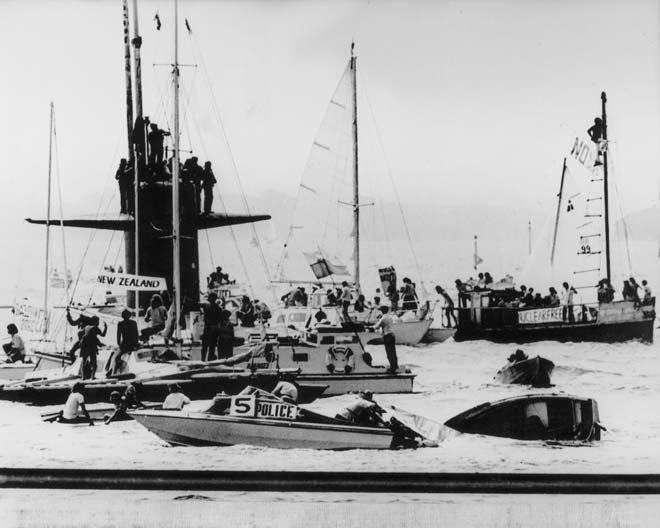
The nuclear-powered and nuclear-armed attack submarine USS Haddo (SSN-604) is barraged by protestors during a port visit to Auckland in New Zealand in 1979.
The treatment of New Zealand was partially intended to deter other more important allies in Europe from adopting similar anti-nuclear legislation. But not surprisingly, the efforts backfired and instead increased opposition. In Denmark the growing evidence that nuclear weapons were actually being brought into Danish harbors despite its clear prohibition soon created political pressure to tighten up the ban. In 1988, this came to a head when a majority in the parliament adopted a resolution requiring the government to inform visiting warships of Denmark’s ban. The procedure did not require the captain to reveal whether his ship carried nuclear weapons, but the conservative government called an election and asked the United States to express its concern.
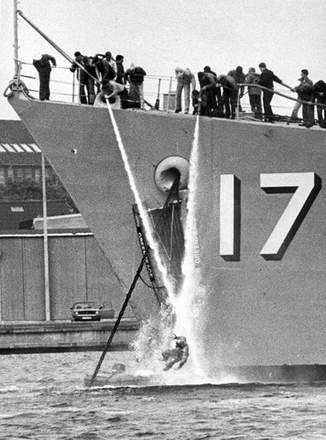
The crew of the nuclear-armed destroyer USS Conyngham (DDG-17) uses high-pressure hoses to wash anti-nuclear protestors off its anchor chain during a standoff in Aalborg, Denmark, in 1988.
Across the Danish Straits in Sweden, the growing evidence that non-nuclear policies were violated in 1990 resulted in the government party deciding to begin to reinforce Sweden’s nuclear ban. The policy would essentially have created a New Zealand situation in Europe, a political situation that was a direct threat to the US Navy sailing its nuclear warships anyway it wanted.
These diplomatic battles over naval nuclear weapons were so significant that many US officials gradually began to wonder if nuclear weapons at sea were creating more trouble than good.
After The Big Nuke Offload
Finally, on September 27, 1991, President George H.W. Bush announced during a primetime televised address that the United States would unilaterally offload all non-strategic nuclear weapons from its naval forces, bring all those weapons home, and destroy many of them. Warships would immediately stop loading nuclear weapons when sailing on overseas deployments and deployed vessels would offload their weapons as they rotated back to the United States. The offload was completed in mid-1992.
Two years later, the Clinton administration’s 1994 Nuclear Posture Review, decided that all surface ships would loose the capability to launch nuclear weapons. Only selected attack submarines would retain the capability to fire the nuclear Tomahawk land-attack sea-launched cruise missile (TLAM/N), but the weapons would be stored on land. Sixteen years later, in 2010, the Obama administration decided to retire the TLAM/N as well, ending decades of nuclear weapons deployments on ships, attack submarines, and on land-based naval air bases.
After the summer of 1992, only strategic submarines armed with long-range ballistic missiles have carried U.S. nuclear weapons at sea, a practice that is planned to continue through at least through the 2080s. These strategic submarines (SSBNs) have also been involved in accidents and incidents, risks that will continue as long as nuclear weapons are deployed at sea. Because secrecy is so much tighter for SSBN operations than for general naval forces, most accidents and incidents involving SSBNs probably escape public scrutiny. But a few reports, mainly collisions and groundings, have reached the public over the years.
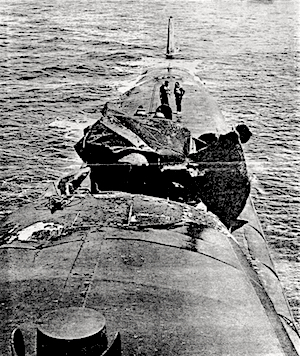
USS Von Steuben (SSBN-632) after collision with tanker Sealady.
During a strategic deterrent patrol on August 9, 1968, the USS Von Steuben (SSBN-632) was struck by a submerged tow cable while operating submerged about 40 miles (64 kilometers) off the southern coast of Spain. As it surfaces, the submarine collides with the tanker Sealady, suffering damage to the superstructure and main deck (see image right). The submarine carried 16 Polaris A3 ballistic missiles with 48 nuclear warheads.
Two years later, on November 29, 1970, a fire breaks out onboard the nuclear submarine tender USS Canopus (AS-34) at the Holy Loch submarine base in Scotland. Two nuclear-powered ballistic missile submarines (USS Francis Scott Key (SSBN-657) and USS James K. Polk (SSBN-645)) were moored alongside Canapus. The Francis Scott Key cast off, but the Polk remained alongside. The fire burns out of control for four hours killing three men. The submarine tender carried nuclear missiles and warheads and the two submarines combined carried 32 Polaris A3 ballistic missiles with a total of 96 nuclear warheads.
Four years later, in November 1974, after having departed from its base at Holy Loch in Scotland, the ballistic missile submarine USS James Madison (SSBN-627) collides with a Soviet submarine in the North Sea. The collision left a nine-foot scrape in the Madison, which apparently dove onto the Soviet submarine, thought to have been a Victor-class nuclear-powered attack submarine. The Madison carried 16 Poseidon (C3) ballistic missiles with 160 nuclear warheads. The Soviet submarines probably carried nuclear rockets and torpedoes. Madison crew members called the incident The Victor Crash. Two days after the collision, the Madison enters dry dock at Holy Loch for a week of inspection and repairs.
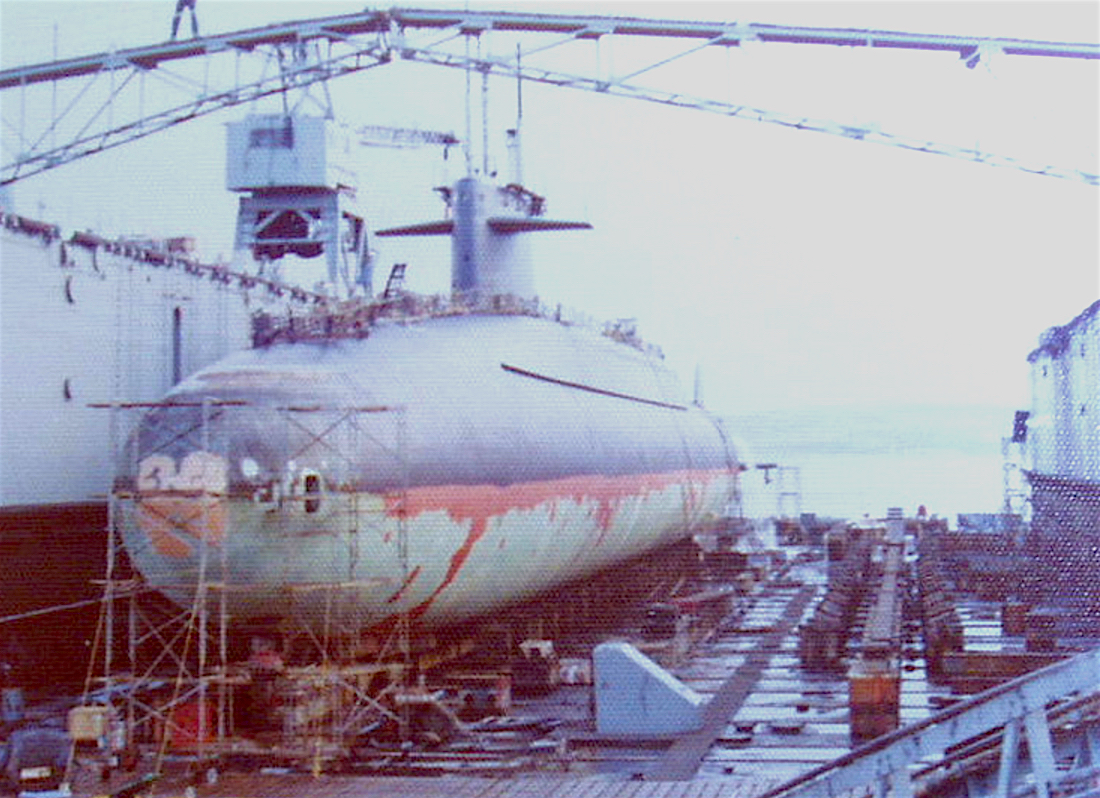
The missile submarine USS James Madison (SSBN-627) in dry dock in Scotland in 1974 only days after it collided with a Soviet Victor-class nuclear-powered attack submarine in the North Sea.
After nuclear weapons were offloaded from surface ships and attack submarines in 1991-1992, nuclear-armed ballistic missile submarines have continued to run aground or bump into other vessels from time to time.
On September 24, 1993, for example, after conducting a medical evacuation for a suck crew member, the ballistic missile submarine USS Maryland (SSBN-738) ran aground at Port Canaveral, Florida. The submarine was on a strategic deterrent patrol with 24 missiles onboard carrying an estimated 192 warheads. The Maryland eventually pulled free and continued the patrol two days later.
On March 19, 1998, while operating on the surface 125 miles (200 kilometers) off Long Island, New York, the ballistic missile submarine USS Kentucky (SSBN-737) was struck by the attack submarine USS San Juan (SSN-751). The Kentucky suffered damaged to its rudder and San Juan’s forward ballast tank was ruptured. In a typical display of silly secrecy, the Navy refused to say whether the Kentucky carried nuclear weapons. But it did; the Kentucky was in the middle of its 21st strategic deterrent patrol and carried its complement of 24 Trident II missiles with an estimated 192 nuclear warheads.
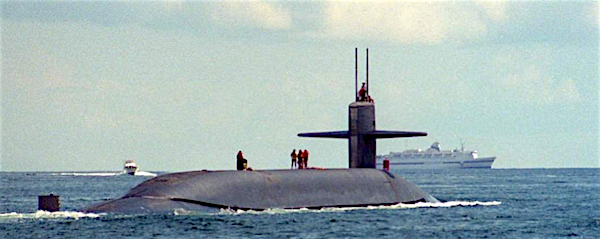
In 1998, the USS Kentucky (SSBN-737) carrying nearly 200 nuclear warheads collided with an attack submarine less than 230 miles (378 kilometers) from New York City.
Conclusions and Recommendations
The Obama administration has made an important contribution to nuclear policy by declassifying the documents with official numbers of US nuclear weapons deployed at sea during the Cold War. This adds an important chapter to the growing pool of declassified information about the history of the U.S. nuclear arsenal.
The new declassified information helps us better understand the extent to which nuclear weapons were involved in day-to-day operations around the world. Every day, nuclear-armed warships of the US and Soviet navies were rubbing up against each other on the high seas in gong-ho displays of national determination. Some saw it as necessary for nuclear deterrence; others as dangerous nuclear brinkmanship. Many of those who were on the ships submarines still get goosebumps when they talk about it and wonder how we survived the Cold War. The tactical naval nuclear weapons were considered more acceptable to use early in a conflict because there would be few civilian casualties. But any use would probably quickly have escalated into large-scale nuclear war and the end of the world as we know it.
The declassified information, when correlated with the many accidents and incidents that nuclear-armed ships and submarines were involved in over the years, also helps us remember a key lesson about nuclear weapons: when they are operationally deployed they will sooner or later be involved in accidents and incidents.
This is not just a Cold War lesson: thousands of nuclear weapons are still operationally deployed on ballistic missile submarines, on land-based ballistic missiles, and on bomber bases. And not just in the United States but also in Britain, France, and Russia. Some of those deployed weapons will have accidents in the future. (See here for the most recent.)
Moreover, growing tensions with Russia and China now make some ask if the United States needs to increase the role of its nuclear weapons and once again equip aircraft carriers with the capability to deliver nuclear bombs and once again develop and deploy nuclear land-attack sea-launched cruise missiles on attack submarines.
Doing so would be to roll back the clock and ignore the lessons of the Cold War and likely make the current tensions worse than they already are.
Instead, the United States should seek to work with Russia – even though it is challenging right now – to reduce deployed nuclear weapons and jointly try to persuade smaller nuclear-armed countries such as China, India, and Pakistan from increasing the operational readiness of their nuclear forces. That ought to be one thing Russia and the United States could actually agree on.
Background information:
- Department of Defense, “Nuclear Weapons Afloat: End of Fiscal Years 1953-1991,” n.d.
- FAS Nuclear Notebook: Declassified: US Nuclear Weapons at Sea During the Cold War, Bulletin of the Atomic Scientists, February 2016.
The research for this publication was made possible by a grant from the New Land Foundation, and Ploughshares Fund. The statements made and views expressed are solely the responsibility of the authors.
While it is reasonable for governments to keep the most sensitive aspects of nuclear policies secret, the rights of their citizens to have access to general knowledge about these issues is equally valid so they may know about the consequences to themselves and their country.
Nearly one year after the Pentagon certified the Sentinel intercontinental ballistic missile program to continue after it incurred critical cost and schedule overruns, the new nuclear missile could once again be in trouble.
“The era of reductions in the number of nuclear weapons in the world, which had lasted since the end of the cold war, is coming to an end”
Without information, without factual information, you can’t act. You can’t relate to the world you live in. And so it’s super important for us to be able to monitor what’s happening around the world, analyze the material, and translate it into something that different audiences can understand.
